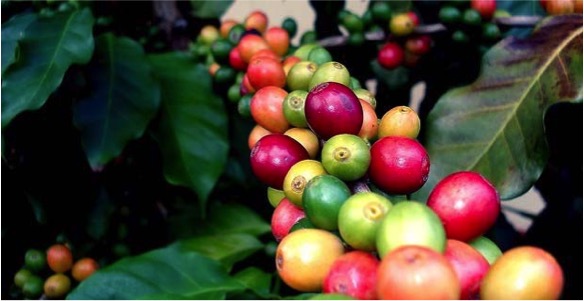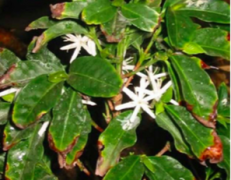Analysis and summary of genetic variation of coffee plants

For professional baristas, please follow the coffee workshop (Wechat official account cafe_style)
Narrow lobe mutant Angustifolia
The varieties with long and narrow leaves and long lanceolate leaves are the main parent sources for the breeding of excellent and good new varieties of coffee. About 5% of C. arabica seedlings have narrow leaves.
It is the recessive factor of two pairs of mutations of ag1 and ag2.
The first generation of hybrids with normal plants is the normal second offspring.
The ratio of 9 to 7 is normal.
It is now one of the official varieties of Arabica coffee.
Malformed mutant An Anomala
The tree shape, leaf shape, flower and fruit of the mutant are all deformed.
There are often 4 seeds in the fruit, and 3 embryo plants in each seed, so it is pseudo-polyembryonic (False Polyembryony), and its factor is a pair of recessive anan.
The variation of malformed mutant B Anomalis is more severe than that of the above aberration.
Leaves are often divided into palms, stamens degenerated, fruit large and discoid, containing several seeds.
Is a pair of incomplete dominant factors AmAm
The first generation is intermediate and often infertile.
Brown leaf mutant Bronze
The leaves of normal seedlings are green.
The young leaves of this mutant are brown, while the old leaves are still green.
The factor is a pair of dominant, dark brown in BrBr, light brown in Brbr and green in brbr. However, there may be other allelic factors that affect the depth of brown.
Leaf color and fruit color are inherited independently and do not affect each other.
Calyx mutation Calycanthema
The sepal of the common coffee is very small, while the calyx of this variety is very large like a petal.
Except for the degeneration of stamens, all the other characters were similar to the parent Typica.
The first offspring of crossing with normal plants had 50% normal and 50% coronal calyx, which seemed to be the result of backcross.
Therefore, it is assumed that the factor is a pair of dominant Cpene cc and Cc is a coronal calyx. Because of its stamen degeneration, there is no way to self-cross to obtain pure dominant plants of CC.
Dwarf mutant Caturra
The plant is similar to the parent Bourbon but small, short internodes and high yield, so it has become a cultivated variety.
The varieties with similar Typica mutations are Sao Bernado and San Ramon.
The factor was a pair of dominant CtCt, which was crossed with normal plant, and the first generation was dwarf plant Ctct.
50% dwarf plants (Ctct) and 50% normal plants (ctct) were backcrossed with normal ctct.
The progeny of backcrossing with dwarf plant CtCt were dwarf plant (CtCt and Ctct).
From Typica.
Yellow endosperm mutant Cera
The normal endosperm of Arabica is green.
The other characters of this variety were the same as those of Arabica except that the endosperm was yellow.
The factor is the allelic recessive gene of green endosperm.
Both CeCeCe,CeCece and Cecece were green, only cecece was yellow endosperm and had pollen direct sensation (Xenia).
Wrinkled leaf mutant Crespa
The leaves are small and wrinkled, the plants are short and fruiting is very few.
It is a pair of dominant factors CrCr.
At first, it was only a unit factor mutation, and the genotype was Crcr.
When crossed with normal plants, half of the offspring were wrinkled leaves and half were normal.
Orthotopic mutant Erecta
The branches of the normal Arabica incomplete dominant plants were at an angle of about 65 degrees from the trunk, while that of this mutant was only about 25 degrees, so the branches grew upright upward, and other characters were the same as those of the normal plants.
Erectile inheritance is a pair of completely dominant factors ErEr.
The heterozygote was also erect at Erer, and the second generation was erect at 3:1 as normal.
Clustered mutant Fasciata
There are two kinds of clump type: one is hesitation variation, which can not be inherited.
What is described here is a heritable cluster mutation.
The branches are banded, the leaves are dense and clumpy, the petals can be increased to 12, the stamens increase, the stigmas gather to form bands, there are two carpels in the ovary, the inner whorl is completely sterile, the outer whorl can produce seeds but has no use value, meiosis is abnormal, and some pollen is sterile.
Its inheritance is a pair of completely dominant factors, and the variation is particularly significant in FsFs, slightly clustered in Fsfs, and normal in fsfs.
Important Notice :
前街咖啡 FrontStreet Coffee has moved to new addredd:
FrontStreet Coffee Address: 315,Donghua East Road,GuangZhou
Tel:020 38364473
- Prev

Genetic chromosome and Factor mutations in Coffee plants
Communication of professional baristas Please pay attention to Coffee Workshop (Wechat official account cafe_style) Coffee plants hereditary Coffee plants heredity is very complex, except Arabica coffee is 2n=4x=44 (heterotetrad), the rest is 2n=22. Medium-grain coffee (Coffea canephora, 2n=2x = 22) grows well and can be used as a genetic research material. Go up
- Next

Introduction to Le Roy Lloyd's Coffee (Laurina; Bourbon Pointu) Bourbon Tip
Professional baristas exchange please follow the coffee workshop (Wechat official account cafe_style) Le Roy Lloyd's Coffee (Laurina; Bourbon Pointu) bourbon sharp body mutated from Bourbon, is a variant of var. Laurinan DC, short tree, conical, small leaves, but good quality beans-slightly sour, low bitter, meticulous, with vanilla, citrus, almonds and
Related
- Does Rose Summer choose Blue, Green or Red? Detailed explanation of Rose Summer Coffee plots and Classification in Panamanian Jade Manor
- What is the difference between the origin, producing area, processing plant, cooperative and manor of coffee beans?
- How fine does the espresso powder fit? how to grind the espresso?
- Sca coffee roasting degree color card coffee roasting degree 8 roasting color values what do you mean?
- The practice of lattes: how to make lattes at home
- Introduction to Indonesian Fine Coffee beans-- Java Coffee producing area of Indonesian Arabica Coffee
- How much will the flavor of light and medium roasted rose summer be expressed? What baking level is rose summer suitable for?
- Introduction to the characteristics of washing, sun-drying or wet-planing coffee commonly used in Mantenin, Indonesia
- Price characteristics of Arabica Coffee Bean Starbucks introduction to Manning Coffee Bean Taste producing area Variety Manor
- What is the authentic Yega flavor? What are the flavor characteristics of the really excellent Yejasuffi coffee beans?

